
Project News
STRAIGHTSOL Newsletter - Issue 6 available (pdf, 688Kb)
[More]
See our animations
[More]
New deliverables available
[More]
Summary results booklet available
[More]
STRAIGHTSOL evaluation framework resources available
[More]
Open ENLoCC event videos available
[More]
STRAIGHTSOL Newsletter - Issue 5 available (pdf, 193Kb)
[More]
Kuehne-Nagel's video: Rail tracking and warehouse management (6:50 mins)
[More]
Demonstration poster presentations available to download
[More]
Wednesday 31st October 2012 - Oslo
STRAIGHTSOL Demonstration Workshop
Smart Urban Transport - Standardising information in retail supply chain management and last-mile distribution
Presentations
- Introduction to STRAIGHTSOL project, Jardar Andersen, TØI
- Oslo Demonstration Overview, Roar Lorvik, GS1 Norway
- Supply chain, last mile, Straightsol, André Swensen, Nille
- Business case opportunities, transport & environmental improvements enabled by in-transit visibility, Jan Arild Torekoven, Schenker AS
- The shopping centre owner's perspective, Steen & Strøm
- Draft results from demonstration, Jardar Andersen TØI
Workshop report - Introduction
The aim of this STRAIGHTSOL workshop was to present the GS1 Oslo demonstration to those interested in and affected by urban logistic activities. This included, in particular, stakeholders such as retailers, shop owners, shopping centre managers, transport and logistics service providers, municipality planners and policy makers.
The workshop was organised by GS1 Norway in collaboration with the Institute of Transport Economics (TOI).
The aims of this Straightsol workshop were to:
- Present the GS1 Oslo concept and draft findings from the demonstration
- Capture views from the main stakeholders involved in or affected by the demonstration
- Showcase the facilities at the freight receipt area at the Stovner shopping centre
- Promote discussions of advantages and disadvantages of the demonstrated concept
The workshop sessions comprised presentations at GS1 offices, followed by a technical visit and presentations at the Stovner centre and a return to GS1 offices for a presentation of the GS1 Smart Centre, questions and discussions.
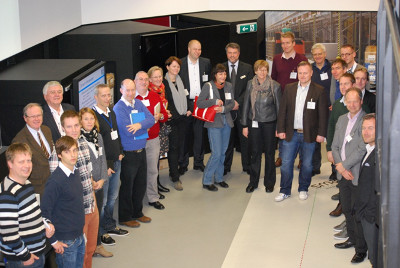
Some of the participants at the GS1 Smart Centre
Description of STRAIGHTSOL and GS1 Oslo demonstration
The workshop moderator, Mr. Anders Askevold (GS1 Norway), welcomed the audience (33 people) representing stakeholders like logistic service providers, transporters, consultancy firms, public policy makers and the municipality. His introduction was followed by Mr. Jardar Andersen (TOI), coordinator of the STRAIGHTSOL project who presented the project's approach, aims and activities, and gave a brief presentation of the other six demonstrations in the project.
Mr. Roar Lorvik (GS1 Norway) presented the GS1 demo, which demonstrates how automatic data capturing and event information sharing, enabled by global standards and Auto-ID technology, can make critical points in the supply chain visible. This makes it possible to take actions in last mile value chains to make them more efficient and environmentally friendly, and gives shorter waiting-, delivery- and loading times. This is achieved through improved efficiency, quality of deliveries and service, decreased error rates, better resource utilization and reduced capital and operational costs, with benefits envisaged for the environment as well as for the distribution centre, transporter, goods receivers, the shopping centre and the shops.
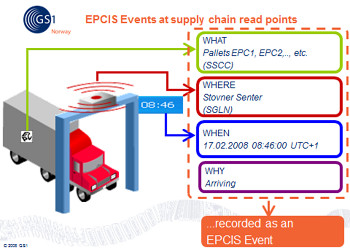
Electronic Product Code Information Services events
The demonstration took place at Stovner senter, a shopping centre in Oslo with approximately 100 shops. The centre receives deliveries from multiple warehouses in the Oslo area. The centre is owned by the Steen & Strøm Corporation of shopping centres, which is one of the two largest shopping centre owners in Norway with activities also in the other Nordic countries.
The demonstration involved the shopping centre manager, shops in the shopping centre, logistics service providers and shippers of goods. The demonstration is testing deliveries to six shops at Stovner senter, served by different logistics service providers:
- Nille AS (general retail) - served by Fløtten transport
- Mester Grønn (flowers) - delivering goods with own transport
- Dressmann (fashion) - served by DB Schenker AS Norway
- Bik-bok (fashion) - served by DB Schenker AS Norway
- Ark (bookseller) - served by BRING logistics
- Gresvig/G-sport (sports equipment) - served by Tollpost Globe
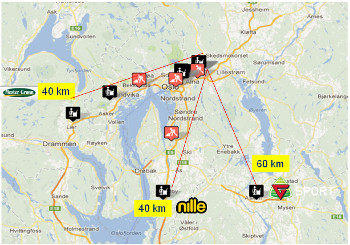
Three of the valule chains in the Oslo Demo
In the Oslo GS1 demonstrator supply chain there is data capturing at the retail chain/LSP warehouse/terminal, receipt at shopping centre and at the retail shop. As an example, the deliveries of Nille AS were illustrated. At Nille AS's warehouse, goods are picked which are then assembled on pallets for deliveries to Nille's shop at Stovner senter. The pallet loads of goods are wrapped in plastic (e.g. cellophane) and are labelled with a barcode; the pallets destined for the Stovner Senter also have a label with a RFID (Radio Frequency Identification) tag containing a Serial Shipment Container Code (SSCC). The RFID tag gives easier data capturing at all critical points in the supply chain, and several RFID tagged pallets can be read simultaneously. (Nille uses barcode labels with SSCC for all other pallets to different destinations other than Stovner.)
When a pallet is ready it is registered at the delivery area and the registered data is sent to the EPCIS (Electronic Product Code Information Services) server. When dispatching the goods, the captured data is used to check that the consignment matches the advised goods. The captured data also gives increased accuracy and data quality for transport planning.
Information is collected at different critical points through the last-mile delivery, such as 'goods at loading bay', 'out of warehouse', 'in transit' (GPS Geofencing), 'freight receipt in the shopping centre', 'receipt at receiver's premises' etc. All captured data are sent to the EPCIS server and captured information is shared between involved parties in a supply chain, according to the specified data sharing rules.
In the 'before' situation, the truck driver brings all items directly to the stores. In the new situation, with information sharing, the truck driver brings goods to a reception area with buffer storage. The buffer storage is the next critical point in the supply chain for data capturing by a responsible person from the mall and the truck driver get a receipt for the delivered goods. In the 'after' situation, the responsible person from the mall brings the goods from the buffer storage area to the shops. This way of organizing the deliveries gives significantly shorter delivery times. Information from the EPCIS server is sent to the stakeholders via email or SMS text messages.
Experiences and results so far
The next presentation was given by Mr. Andre Swensen, head of logistics at Nille AS. Nille AS is a low price retailer with over 300 stores in Norway, selling an assortment of merchandise such as home decorations, seasonal items, birthday goods and candles. Nille AS joined the project because, today, there is no real 'track and trace' and information flow between wholesalers and shops is poor. There are no real data for statistics and hence no opportunity to have more effective deliveries. Nille AS want better logistics at shopping centres including less time on handling pallets, no pallets in the shops when there are customers, more pallets in each truck and less driving per truck. Nille's main target is visibility through the entire delivery process and live data to support the logistic department and store managers. Another reason for joining this project is that the company wants to find a system that is easily transferable to other countries where the company establishes shops. The retailer also wants to have a system that supports environmental responsibility and strict environmental rules. As part of the presentation, Nille showed a video they had produced. A version of this video, with commentary added, can be viewed from the Straightsol website: http://www.straightsol.eu/videos.htm
Mr. Jan Arild Torekoven (Schenker AS) emphasized that the main challenges are connected to unloading areas with restricted facilities and capacity resulting in queues, time slot issues and deliveries requiring custom vehicle sizes. In addition, internal transport routes in the malls can be long when delivering to shops and the internal transport and delivery activities are time consuming. A further challenge is that retail chains have different requirements for shipping time and often require deliveries several times per day. He stressed that logistics and services in shopping centres can be improved by better availability of unloading areas in relation to goods receipt and better design of shopping centres. One way to improve logistics is to offer serviced buffer storage areas in malls. Such a service can provide an upside for the retail shops in the mall, when it comes to predictability. The service could be organized as a purchased service or hosted by the mall itself. The service will give the ability to coordinate different deliveries, and involve significantly less internal transport. For the logistic service providers a logistics solution with buffer storage and coordination of goods deliveries at the mall, in partnership with retail chains and centre management, will provide predictability and reduced number of deliveries. Information in the supply chain will be better through arrival messages, traceability and deviation messages.
Draft results from the demonstration were presented by Mr. Jardar Andersen (TOI). Main conclusions to date are that the shop owners are pleased with the new information provision, but it is noted that different supply chains have needs for different solutions. When using buffer storage, interviews with truck drivers indicated between 4 and 15 minutes saved per pallet delivered, but the efficiency of introducing the buffer storage depends on whether all or some pallets can be left in buffer storage. Also there is a need to consider coverage of costs and business models. In addition to the direct effects of introducing the buffer storage there are indirect effects connected to time savings like more efficient operations, new route and route fleet optimization and fewer constraints related to rest time of drivers.
Further work on the demonstration will focus on continuation of data collection and interviews to allow proper comparison of before/after situations, costs and benefits for stakeholders, business model opportunities and transferability of further roll-out.
Steen & Strøm, the owner of Stovner senter, was represented by Mr. Sverre Østvold. He stressed that Steen & Strøm involved themselves in the project because it could contribute to their plans for further environmental work in development of new shopping centres. This is connected to an internal energy and waste management project where one of the main aims is to have better transportation and less traffic to and from shopping centres. In short they would have more efficient deliveries. Mr. Østvold suggested a follow-up workshop with all stakeholders involved in the Oslo GS1 demonstration to discuss business model aspects.
Showcasing of facilities at Stovner
In the freight receipt area at the Stovner centre it was demonstrated how a guard from the shopping centre's security company (Securitas) receives the goods from the truck drivers and scans them with an RFID scanner. The pallets are then brought to the secure buffer storage area close to the freight receipt area. After that the participants followed the Securitas guard bringing pallets to a shop and scanning them again there.
In the centre Mr. Espen Braathe and Mr. Geir Vevle (Enlight - software providers) presented the information sharing 'Dashboard' that was used in the demonstration and the possibilities for further information sharing and integration with other tools such as map services with traffic information. They mentioned that in Norway data privacy is an important issue as, for example, driver permission must be sought before vehicle tracking is permitted.
GS1 Smart Centre
After the visit to Stovner, the participants returned to the GS1 Norway offices. The GS1 Smart Centre was then presented. The Smart Centre showroom visualizes a full supply chain interactively, and the technical possibilities and benefits from information capturing and sharing are visualized.
Discussion and future outlook
Future outlook for the GS1 Oslo demonstration is to intensify the collaboration between stakeholders (e.g. possible off-hour deliveries based on buffer storage) and to continue data collection and interviews to allow proper comparison of before/after situations. In this context business model opportunities, dialogue, costs and benefits for all stakeholders must be better understood. Today only the pallets are traced, this should be expanded to tracking of the items on the pallet. Another challenge is to consider further roll-out by involved stakeholders (Nille AS and GS1 Norway are already discussing the possibilities for expansion) and transferability to others. The possibility of extending the project must be discussed and more stores must be involved to test the solution before final conclusions can be drawn.
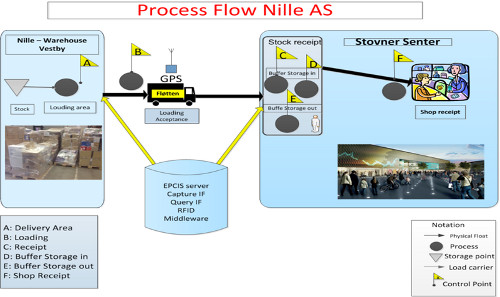
Process flow at Nille AS
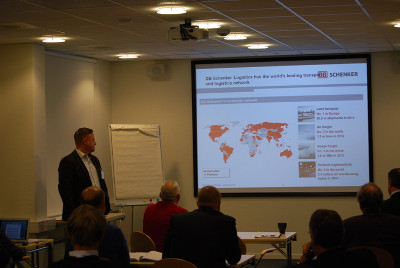
DB Schenker presentation
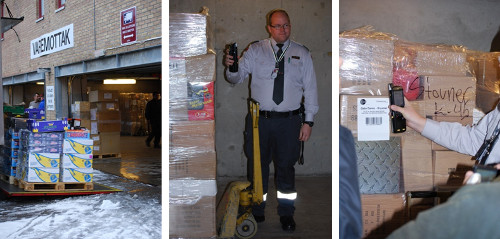
Freight receipt at Stovner senter
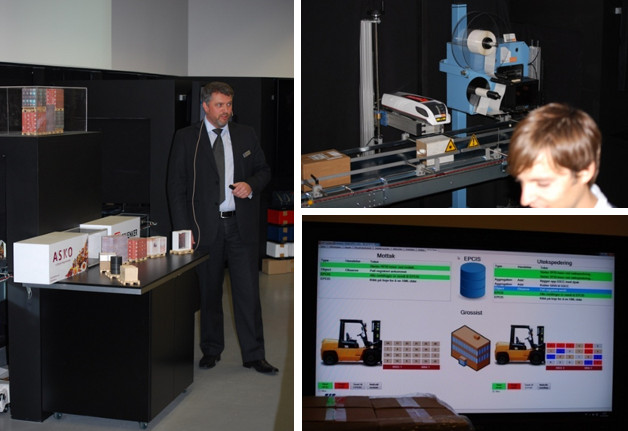
Pictures from the GS1 Smart Centre

Events
29/08/2014
Project Final Review meeting, Brussels
12/06/2014
Smart Urban Freight Conference hosted by NewRail, Newcastle University, including contributions from Straightsol project
[Conference webpage]
13/06/2014
Evaluation Framework Training Sessions, Newcastle University
[More]
02/04/2014
Open ENLoCC event, Brussels, including presentation of Colruyt and Delhaize night-time deliveries demonstration
[More]
24/09/2013
Demonstration Results Workshop/Exhibition in Amsterdam
[More]
02/07/2013
TNT Express demonstration workshop in Brussels
[More]
23/04/2013
Oxfam demonstration workshop in Batley, near Leeds, UK
[More]
07/03/2013
DHL Supply Chain demonstration workshop in L'Hospitalet de Llobregat/Barcelona, Spain
[More]
31/10/2012
Oslo: Demonstration workshop
Smart Urban Transport - Standardising information in retail supply chain management and last-mile distribution
[More]
13/09/2012
Thessaloniki: Demonstration workshop
"Intelligent" systems for the interconnection of urban-interurban freight transport
[More]
03/07/2012
Brussels: STRAIGHTSOL project workshop on Smart Urban Freight Solutions
(in collaboration with the Smartfusion partnership)
[More]